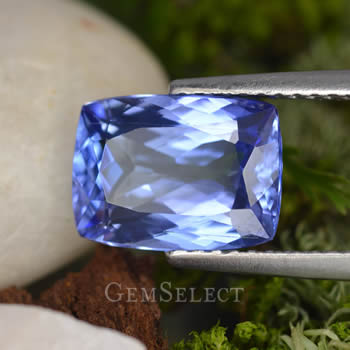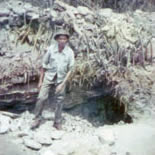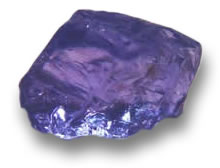Discovery of Tanzanite
There are several accounts of the discovery of tanzanite, named after Tanzania, its country of origin. According to some, the history of tanzanite is that it was first discovered by Masai tribesman, Ali Juuyawatu. Other reports say that Ndugu Jumanne Ngoma first found tanzanite. Yet a further account credits Manual de Souza with the discovery of tanzanite July 7, 1967. Referred to by some as Mad Manuel, this colorful character was well known for his passion for trekking the African bush in search of the unknown, or even the unfindable, as he was wont to describe his activities. Discover our extensive range of loose tanzanite for sale.

Cushion-Cut Tanzanite Gemstone
Born in Goa in 1913, de Souza moved to Tanganika at the age of 20, where he qualified as a master tailor. An adventurer by nature, this trade quickly palled and he began his life as a prospector on the Lupa goldfields of Western Tanganyika, moving on after post-war conditions made gold mining unprofitable to the Shinyanga Diamond Fields. This venture became unviable in the 1960s when a monopoly made diamond prospecting licenses almost impossible to obtain, prompting Manuel to move to the Kilimanjaro area, where he continued to prospect around Lake Victoria, supplementing his income by tailoring.
 |
| Manuel de Souza |
Around the Easter weekend of 1967, what he describes as 'itchy feet' drove him to hire a pickup truck to drop him in the bush in an area in the region of Arusha. Serendipitously, the driver refused to go further than Merelani. With no way of transporting his gear any further, Manuel was forced to fossick for gems in that area instead.
Hiring four Masai tribesmen as his porters, he set off to explore, and around noon on July 7th found a transparent blue stone which he first mistook for a sapphire. After testing its hardness, he immediately knew his find was not sapphire. Nonetheless, de Souza took the stone back to Arusha with him where he tried to identify it by referring to a small volume on mineralogy, which was his only source of reference.
 |
| Tanzanite Rough |
The closest match he could find for his stone was olivine, and thus the first tanzanite claim was duly registered in his name on July 25, 1967 - as an olivine claim.
It was not long before the gem was revealed to be composed of a different material to olivine or peridot. Likewise, dumortierite, cordierite and zoisite were considered and rejected.
Eventually the gems were sent to the Gemological Institute of America which had the necessary equipment to accurately identify the stone as zoisite. At the around the same time, samples were identified at Harvard University, the British Museum, Heidelberg University, and by a Tanzanian government geologist named Ian McCloud, who is credited with being the first to have made the correct call.
Despite its beauty, there was initially no market for this material, with the head of the jewelry department at Saks Department Store in New York declining to stock it. However, after two rings made from the original find impressed the Vice President of Tiffany & Co., the stone was christened tanzanite, creating a new market for it.
|
